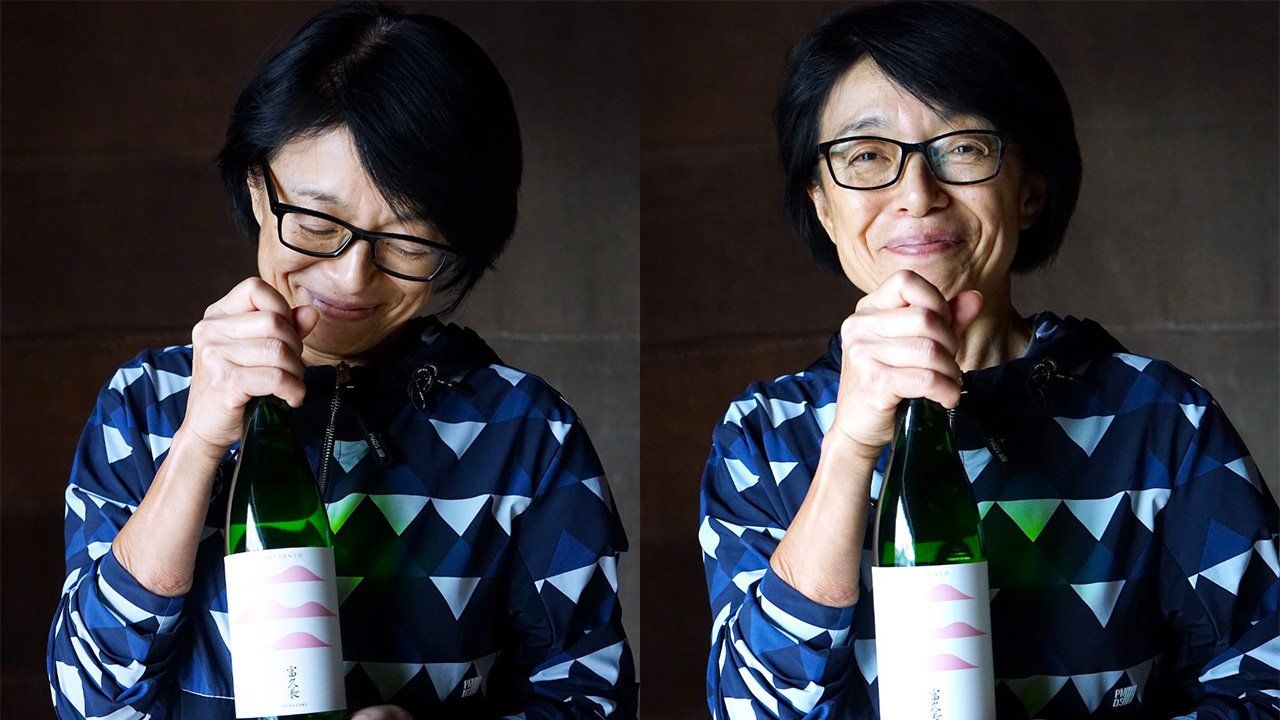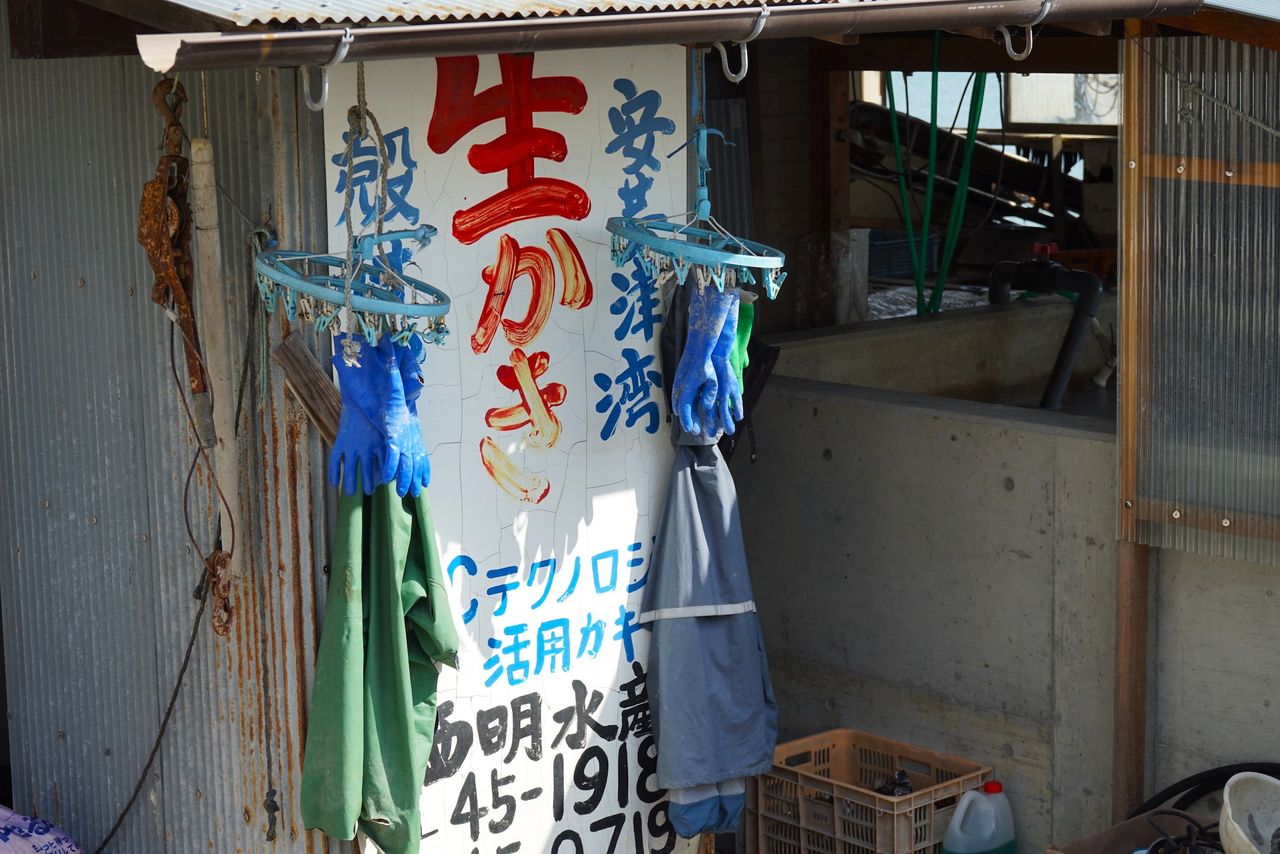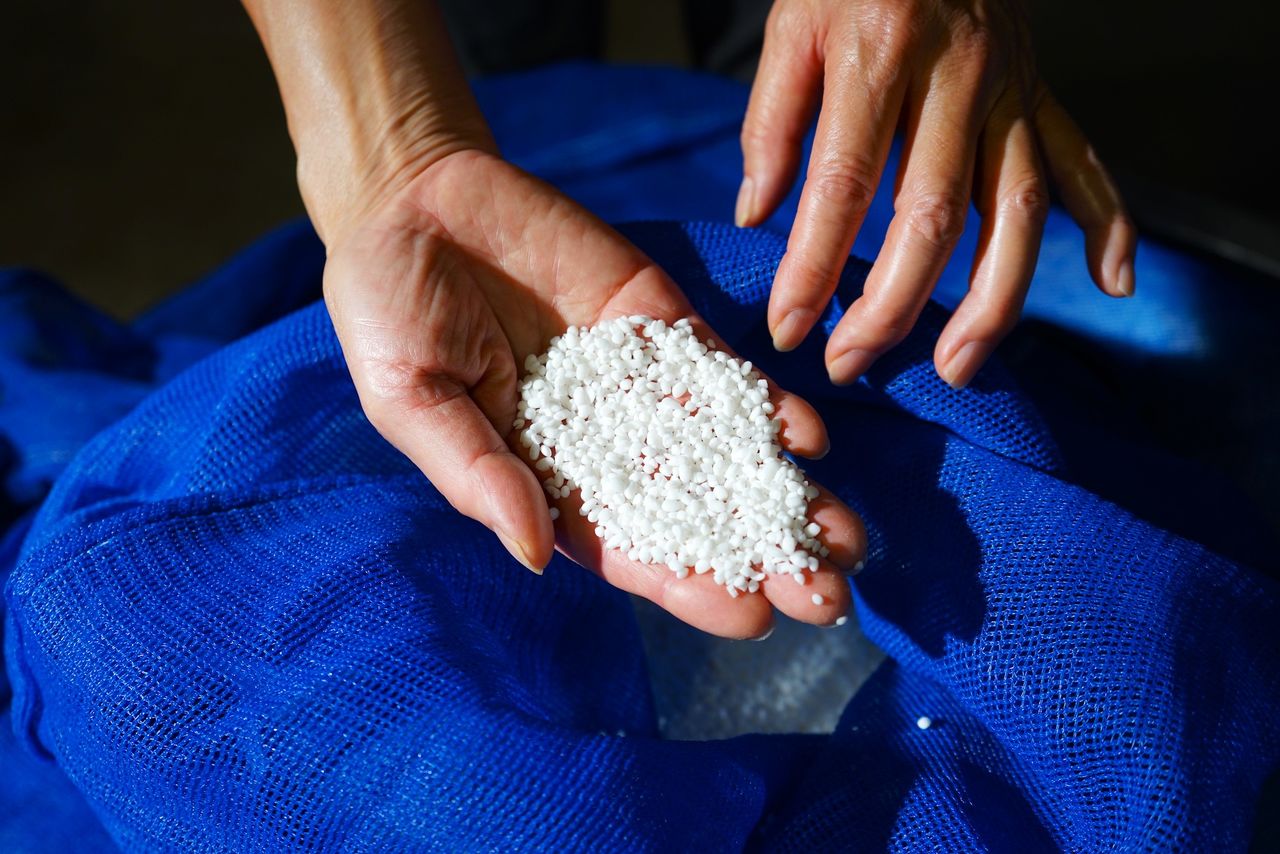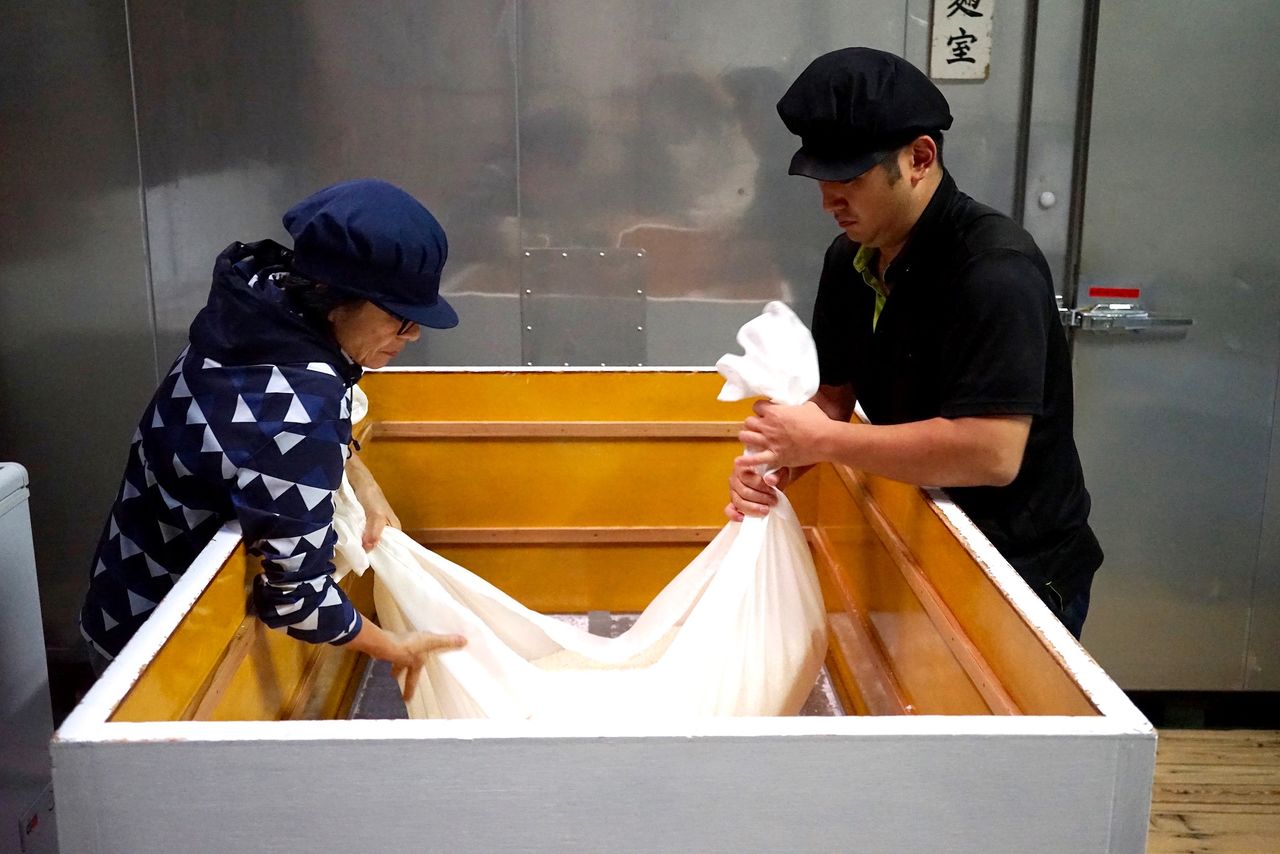
Japanese Agriculture for a New Era
Hiroshima Sake Brewer Imada Miho’s Path to Going Global
Food and Drink Culture- English
- 日本語
- 简体字
- 繁體字
- Français
- Español
- العربية
- Русский
Environment and People at the Heart of Sake
“I can’t step away from brewing in the morning, so please come in the afternoon. If you have the time, take a look around the surrounding area, too. There are some spots I can recommend.”
That is the answer I got when I contacted owner and tōji (head brewer) Imada Miho of Hiroshima’s sake brewery Imada Shuzō Honten at the end of October 2023 about a visit to her brewery. She recommended two spots. One was the Ōshiba Bridge, crossing over the Seto Inland Sea to the island of Ōshiba, and the other was Sakakiyama Hachimangū shrine in the Akitsu district of the city of Higashihiroshima, where the brewery stands.

The Ōshiba Bridge offers a gorgeous view of the Seto Inland Sea. (© Ukita Yasuyuki)
From the bridge, I could look out over the quiet surface of the sea, dancing with countless specks of light, with a backdrop of island silhouettes in varying shades of blue. I wondered if anyone raised around such scenery could ever develop an anxious, agitated kind of personality.
At the Sakakiyama shrine, I found a bronze statue of Miura Senzaburō. Born in 1874 in what is now the Mitsu area of Akitsu, Miura was key in developing a method to brew high-quality sake from the very soft local water, which many had thought impossible. He shared his method with local brewers, which helped turn Hiroshima into a sake brewing powerhouse and Akitsu into a town known for outstanding tōji.

The seas off of Akitsu are filled with oyster farms. (© Ukita Yasuyuki)

The main hall at Sakakiyama Hachimangū. The precincts also have a shrine to the guardian divinity of sake brewing, Matsuo-sama. (© Ukita Yasuyuki)

The statue of Miura Senzaburō. (© Ukita Yasuyuki)
I imagine that Imada’s motive for recommending these two spots was so I would see what stands at the heart of sake brewing: the natural environment and people.
The port of Akitsu was once a major rice distribution center. Then, people started using that rice to brew sake as a higher value product. At its peak, the town boasted some 300 tōji, who would travel far beyond the local area to earn money brewing during the winter. Now, though, only two breweries remain in Akitsu: Imada’s, and Tsuka Shuzō.
When I arrive at the brewery, Imada appears to greet me in a central courtyard fluttering with large white cloths hung up to dry, undoubtedly after seeing use in the morning brewing. She wears a beaming smile.

The main entrance at Imada Shuzō Honten is decorated with a sugidama, or cedar ball, which is a traditional symbol of the sake brewing season. (© Ukita Yasuyuki)

An iconic red brick chimney. The Fukuchō brand name depicted on it was bestowed by Miura Senzaburō. (© Ukita Yasuyuki)

The shimenawa—a twisted straw rope used in Shintō to cordon off sacred areas—across the entrance to the brewing area was made by a previous tōji. Tōji of the generation before Imada’s were often people with skills ranging wide beyond sake brewing. (© Ukita Yasuyuki)
Leaving Home to Better Understand
“The coasts of Hiroshima have the highest risk of natural disaster in Japan,” Imada says. The landscape is dominated by steep mountains that extend right to the edge of the Seto Inland Sea, with ground that primarily consists of granite. When saturated, granite tends to crumble easily, leading to frequent disasters after heavy rain. In fact, on this visit to the brewery, I found the road was still washed out in several places after a flood six years ago, requiring significant detours. However, that unusual ground structure is also one reason for the local area’s soft water.
All the sake under Imada Shuzō Honten’s Fukuchō label display a characteristic gentleness and delicacy thanks to the area’s soft water. But there is also a firm core to the gentleness and complexity beyond the delicacy.
Imada was born in 1961, the eldest daughter of five children, and she says her dream was to go to university in Tokyo. Her father, Yukinao, was the third-generation head of the family brewery, founded in 1868. However, the sake brewing business was in a terrible slump, and he told his children, “Don’t worry about taking over the family business, just search for your own path.”
When Imada left for Tokyo to go to university, Japan was on the ascent in its high-energy “bubble economy” era. She looks back and says that Tokyo felt like a kind of paradise after being freed from her hometown’s conventional thinking. After graduation she took a job with a department store, then took work with a group promoting nō plays. She enjoyed drinking and wandered the city looking for good drinks. She also happened to be there during a time when the sake industry was going through a massive change.
Sake had been legally classified in a three-tiered system called the kyūbetsu seido—with basic top-, first-, and second-class rankings—but that was dropped for a new system based on production methods and ingredients, using the now familiar names like junmai, ginjō, daiginjō, and so on. Changes in logistics also meant that fresh sake could be shipped cold and fast. This was also around the time when the government of Prime Minister Koizumi Junichirō pushed through changes in the law, deregulating alcohol sales at convenience stores, and low-price sake packed in paper cartons hit shelves. The capital was wrapped up in a fad for jizake, or hidden sake gems brewed in Japan’s rural regions. Fad followed fad, as bars stocked so-called tanrei karakuchi (light and dry) sake from Niigata and Toyama Prefectures, which gave way to Yamagata’s nōjun umakuchi (rich and savory) sake. Imada soon had a clear sense of just how far behind the times her own family’s sake was.
The bursting of the bubble economy was a turning point. She resolved to join the family business, and so she left behind the paradise of Tokyo and returned to her hometown in Hiroshima.
While she had made up her mind, Imada confesses that she hadn’t really set her heart on staying, saying, “At first, I kept my room in Tokyo so I could go back any time.”
Convinced by the Tōji Spirit
Though she’d been born at a sake brewery, she knew nothing about the actual process. She started out by studying the techniques through a course run by the tax agency’s brewing laboratory in Tokyo, which is now the National Research Institute of Brewing headquartered in Higashihiroshima. But sake brewing is far too difficult to handle with barely six months of study. “It took over ten years to brew the sake I wanted,” she explains.
Imada says that while she was working, the knowledge shared by senior brewers was vital. For example, there is a scene in the 2019 documentary Kanpai! Nihonshu ni koishita onnatachi (Kampai! Sake Sisters), directed by Konishi Mirai, in which Imada nervously visits Akitsu native Ikeda Kenji, the head tōji of Tosatsuru Shuzō in Kōchi Prefecture, to ask for training. Although many regions forbid women from entering sake breweries, Hiroshima brewers were all receptive to her.
In a sake brewery, the tōji is an overall leader, who not only controls sake brewing, but also helps plan the brewery facilities, arranges for rice deliveries and religious rites, and even hires staff. In those “good old days,” the tōji held as much, or even more, power than the brewery owner. That time ended with Ikeda’s generation. But, as the tōji saying goes, “You can never make sake that’s better than the character of the person making it,” and Imada learned the spirit of always seeking to improve both the self and the sake.
“I finally set my heart after seeing how impressive those tōji were.”
There is another saying at Fukuchō, “A hundred tries, a thousand improvements.” It means repeating a cycle of trial and error to bring out the potential of the climate and equipment in pursuit of ever better sake. Imada took those words to heart and set about improving her own sake brewing.

Imada hand-checking polished rice. When I comment, “Sake brewers always have such nice hands,” she retorts, “This is still the warm season.” (© Ukita Yasuyuki)

Imada and her staff bring the finished kōji rice (steamed rice and kōji mold) from the kōji room, where rice is inoculated with the vital mold spores. This 48-hour process is decisive for sake quality. (© Ukita Yasuyuki)

The moromi, or fermentation mash. Yeast consumes sugar to make alcohol and carbon dioxide, which bubbles to the top with a fizzy sound that announces a healthy fermentation. (© Ukita Yasuyuki)
Reviving a Dormant Rice Variety
The point where Imada finally started to feel satisfied with her own sake brewing was in 2014, when the brewery introduced a new rice steamer. To the layman, it just looks like a big stainless-steel tank, but apparently it’s a vital, high-performance piece of equipment. Brewing good sake depends on setting a solid foundation of perfectly steamed rice. With this equipment, Imada could finally steam rice the way she wanted, taking the shifting weather into consideration, and this helped her put all kinds of new ideas into practice.

(Left) The first time Imada felt real progress in her brewing was the purchase of the steamer at left. Imada compares steamed rice’s importance to that of soil in plant cultivation. At right, Imada checks fermentation progress in the tanks. When fermentation reaches its best state, the brewery needs to immediately press, bottle, and pasteurize the sake to ensure it retains its freshness. (© Ukita Yasuyuki)
Looking at the broad span of the last 80 years, sake brewing has shifted from an age of modernization—rationalization and standardization throughout the industry—to one of diversification, heightened individuality, and a return to the origins of the craft. One of Imada’s projects follows that progression with the revival of a local native rice variety called Hattansō.
Hattansō is an ancestor strain of the modern, popular sake-brewing rice variety Hattan Nishiki and considered the oldest existing variety of native Hiroshima brewing rice. The stalks grow very high—over 160 centimeters—and it grows best in cultivation environments at higher elevations. This makes it hard to raise. It also results in low yields, and with agricultural improvements, it fell out of favor some 100 years ago. However, by a strange chance, Imada ended up with a handful of seed rice from a prefectural gene bank. Imada had always wanted to make sake unique to the region, so she worked out a plan to revive and grow the old rice along with staff member and now head of production Sugiura Hiromasa, who had studied rice breeding at Kyoto University.

Hattansō can grow over 160 centimeters in height. (© Kikui Hiroshi)
With cooperation from the local Japan Agricultural Cooperative and sake rice farmers, they spent six years cultivating the rice until finally they had enough to brew a single tank of sake. The sake made from Hattansō is marked by an assertive acidity that expresses itself from the first taste and lasts through the finish, with a rustic aroma reminiscent of grass. Today, around 40% of the brewery’s sake is made from Hattansō, including its flagship Fukuchō Hattansō Junmai Ginjō.

From left: Fukuchō Hattansō Satake Series Henpei, showing off how a revolutionary new flat rice polishing technology differs from conventional round polishing; Fukuchō Hattansō Junmai Ginjō; and Fukuchō Hattansō Junmai Hybrid Kimoto. (© Ukita Yasuyuki)
The Fight to Go Global
Reviving Hattansō is not the only challenge Imada has taken on. Some 10 years ago, a chef in Tokyo asked her to make a sake that would pair well with oysters, so she developed Fukuchō Seafood Junmai (sold in the United States as “Seaside”). It uses a blend of kōji, with both the yellow version conventionally used in sake brewing along with white kōji, typically used in producing the distilled spirit shōchū. The results are also popular overseas, and this sake has become the brewery’s chief earner.
The Hybrid Kimoto brings another kind of individuality, based not on rice or kōji, but on the complexity of natural lactic acid bacteria. The kimoto process uses these bacilli as part of the very first step in the brewing process, making a fermentation starter or moto. It results in powerful, deep flavors, but requires a lot of skill and hard work, so in modern times it has largely been replaced by more efficient approaches. However, there are still breweries—like Imada Shuzō— that choose to use the older method for the stylistic variety it brings, while avoiding the risks of that delicate process to express all the charms and flavors of the style.
Two years ago, the brewery undertook another challenge, creating a sake to pair with Sichuan huoguo hotpot. After a year of development, it fell on a sake that delicately balances powerful acidity and sweetness in Fukuchō To, limited to sales in China.

Fukuchō Seafood Junmai (left) and Fukuchō To (right) made to pair with Sichuan hotpot. (© Ukita Yasuyuki)
“From a broader view, I think that offering a variety of flavors and styles is how the sake industry will survive. As young people drink less and less alcohol and the population falls, there’s little hope for the domestic market. Which means our market has to be the world. How can we get people everywhere to drink sake?”
The value of sake sales is, in fact, shrinking, but when looking only at exports the numbers have been going up for the past decade. At the same time, there are now over 60 breweries making sake in countries like the United Staes, Mexico, France, Spain, and Norway (including Japanese companies with facilities overseas). They are letting their imaginations run free to break away from conventional ideas and brew unique sake. Imada sees in that a danger of Japan losing the security of its place as sake’s original home.
While Imada seems to have become the face of the sake brewing industry, with her selection by international media and appearance in films, the woman herself shows no hunger for the spotlight or affectation because of it.
“Lately, I’ve been more interested in old-fashioned sake brewing styles, like using less-polished rice, bringing the flavor of wooden tanks, or making sake with lactic-acid bacilli aromas like doburoku [a rustic, unpressed, homemade fermented rice drink].”
To achieve sake’s potential as a global drink, in the end, Imada’s plan is to keep on making sake her own way, expressing the flavor of Akitsu, and continuing the cycle of “a hundred tries, a thousand improvements.”

Imada Shuzō Honten and the streets of Akitsu. (© Ukita Yasuyuki)
(Originally published in Japanese. Banner photo: Imada says, “What I like is how much beauty there is to fall in love with in sake brewing, from fresh-washed rice, finished fermentation starter, and the moromi during fermentation.” © Ukita Yasuyuki.)